Recycling Disassembled Automotive Plastic Components for New Vehicle Components: Enabling the Automotive Circular Economy
Abstract
1. Introduction
2. Results and Discussion
3. Materials and Methods
3.1. Model Materials
3.2. Injection Molding
3.3. Characterization
3.3.1. Particle Size Analysis
3.3.2. Fourier-Transform Infrared (FTIR) Spectroscopy
3.3.3. Thermogravimetric Analysis (TGA)
3.3.4. Differential Scanning Calorimetry (DSC)
3.3.5. Mechanical Testing
3.3.6. Heat Deflection Temperature (HDT)
3.3.7. Density
3.3.8. Rheology
3.3.9. Statistical Analysis
4. Conclusions
Supplementary Materials
Author Contributions
Funding
Data Availability Statement
Acknowledgments
Conflicts of Interest
References
- OICA. World Motor Vehicle Production by Country/Region and Type 2025; OICA: Paris, France, 2025. [Google Scholar]
- ACEA. Economic and Market Report: Global and EU Auto Industry—Full Year 2023; ACEA: Brussels, Belgium, 2023. [Google Scholar]
- U.S. Department of Energy. Vehicle Registration Counts by State; Alternative Fuels Data Center: Washington, DC, USA, 2023. Available online: https://afdc.energy.gov/vehicle-registration (accessed on 3 May 2025).
- Kelley Blue Book. Kelley Blue Book Report: Average New-Vehicle Prices Climb Higher For Fourth Consecutive Month, Flirt with All-Time High; Kelley Blue Book: Irvine, CA, USA, 2025; Available online: https://www.coxautoinc.com/insights-hub/december-2024-atp-report/ (accessed on 3 May 2025).
- Rose-Glowacki, H. Chemistry and Automobiles Driving the Future; American Chemistry Council: Washington, DC, USA, 2024. [Google Scholar]
- Korey, M.; Ozcan, S.; Hubbard, A.; Copenhaver, K.; Lamm, M.; Clarkson, C.; Wang, P.; Lobodin, V.; Ryder, M.; Harter, J.; et al. Durable Automotive Plastics Circularity Report; Oak Ridge National Laboratory: Oak Ridge, TN, USA, 2024. [Google Scholar]
- EuRIC. EuRIC Call for Recycled Plastic Contentin Cars; EuRIC: Brussels, Belgium, 2020. [Google Scholar]
- Exchange, T.P. Resin Markets. Available online: https://www.theplasticsexchange.com/ (accessed on 3 May 2025).
- Held, M.; Rosat, N.; Georges, G.; Pengg, H.; Boulouchos, K. Lifespans of passenger cars in Europe: Empirical modelling of fleet turnover dynamics. Eur. Transp. Res. Rev. 2021, 13, 9. [Google Scholar] [CrossRef]
- EPRB. Robust Recycled Content for Plastics in Vehicles Essential to Drive Plastic Recycling in Europe; ERPB: Brussels, Belgium, 2024. [Google Scholar]
- Alyssa Knowlton, S.B.; Bryan Staley, P.E. Analysis of MSW Landfill Tipping Fees–2023; EREF: Raleigh, NC, USA, 2023. [Google Scholar]
- Arcà, A.; Reike, D.; Bening, C.R. Beyond technical trade-offs: How the value chain impacts the deployment of mechanical and chemical recycling in the European automotive plastic sector. J. Clean. Prod. 2025, 489, 144616. [Google Scholar] [CrossRef]
- Mood, S.H.; Yorgey, G.; Perez, M.G. Evaluation of Emerging Plastics—Recycling Technologies and Management Strategies; Washington State Department of Ecology: Lacey, WA, USA, 2023.
- Martín, A.J.; Mondelli, C.; Jaydev, S.D.; Pérez-Ramírez, J. Catalytic processing of plastic waste on the rise. Chem 2021, 7, 1487–1533. [Google Scholar] [CrossRef]
- Korey, M.; Rencheck, M.L.; Tekinalp, H.; Wasti, S.; Wang, P.; Bhagia, S.; Walker, R.; Smith, T.; Zhao, X.; Lamm, M.E.; et al. Recycling polymer composite granulate/regrind using big area additive manufacturing. Compos. Part B Eng. 2023, 256, 110652. [Google Scholar] [CrossRef]
- Walker, R.; Korey, M.; Hubbard, A.M.; Clarkson, C.M.; Corum, T.; Smith, T.; Hershey, C.J.; Lindahl, J.; Ozcan, S.; Duty, C. Recycling of CF-ABS machining waste for large format additive manufacturing. Compos. Part B Eng. 2024, 275, 111291. [Google Scholar] [CrossRef]
- Copenhaver, K.; Smith, T.; Armstrong, K.; Kamath, D.; Rencheck, M.; Bhagia, S.; Korey, M.; Lamm, M.; Ozcan, S. Recyclability of additively manufactured bio-based composites. Compos. Part B Eng. 2023, 255, 110617. [Google Scholar] [CrossRef]
- Munoz Meneses, R.A.; Cabrera-Papamija, G.; Machuca-Martinez, F.; Rodriguez, L.A.; Diosa, J.E.; Mosquera-Vargas, E. Plastic recycling and their use as raw material for the synthesis of carbonaceous materials. Heliyon 2022, 8, e09028. [Google Scholar] [CrossRef] [PubMed]
- Saleem, J.; Tahir, F.; Baig, M.Z.K.; Al-Ansari, T.; McKay, G. Assessing the environmental footprint of recycled plastic pellets: A life-cycle assessment perspective. Environ. Technol. Innov. 2023, 32, 103289. [Google Scholar] [CrossRef]
- Maury, T.; Tazi, N.; de Matos, C.T.; Nessi, S.; Antonopoulos, I.; Pierri, E.; Baldassarre, B.; Garbarino, E.; Gaudillat, P.; Mathieux, F. Towards Recycled Plastic Content Targets in New Passenger Cars and Light Commercial Vehicles; Publications Office of the European Union: Luxembourg, 2023. [Google Scholar]
- Lase, I.S.; Tonini, D.; Caro, D.; Albizzati, P.F.; Cristóbal, J.; Roosen, M.; Kusenberg, M.; Ragaert, K.; van Geem, K.M.; Dewulf, J.; et al. How much can chemical recycling contribute to plastic waste recycling in Europe? An assessment using material flow analysis modeling. Resour. Conserv. Recycl. 2023, 192, 106916. [Google Scholar] [CrossRef]
- Cardamone, G.F.; Ardolino, F.; Arena, U. Can plastics from end-of-life vehicles be managed in a sustainable way? Sustain. Prod. Consum. 2022, 29, 115–127. [Google Scholar] [CrossRef]
- Ford Motor Company. Ford Bronco Sport Features First-Ever Parts Made of 100% Recycled Ocean Plastic. Available online: https://media.ford.com/content/fordmedia/fna/us/en/news/2021/12/08/ford-bronco-sport-recycled-ocean-plastic.html (accessed on 3 May 2025).
- Bowden-Eyre, J. Jaguar Land Rover Will Use Plastic Waste in Next-Generation Sustainable Luxury Interiors. Available online: https://www.jlr.com/news/2020/09/jaguar-land-rover-will-use-plastic-waste-next-generation-sustainable-luxury-interiors (accessed on 3 May 2025).
- Seidel, C. BMW i Ventures Invests in High-Performance Composites Made from Natural Fibres. Available online: https://www.press.bmwgroup.com/global/article/detail/T0377293EN/bmw-i-ventures-invests-in-high-performance-composites-made-from-natural-fibres?language=en (accessed on 3 June 2025).
- Datz, R. The All-Electric Volvo EX30 Small SUV is Designed to have the Lowest Carbon Footprint of Any Volvo Car to Date. Available online: https://www.media.volvocars.com/global/en-gb/media/pressreleases/312698/the-all-electric-volvo-ex30-small-suv-is-designed-to-have-the-lowest-carbon-footprint-of-any-volvo-c (accessed on 3 May 2025).
- Honda R&D Co. Honda and Idemitsu Kosan Begin Joint Demonstration Testing of Closed-loop Recycling of Plastics from End-of-Life Vehicles. Available online: https://global.honda/en/topics/2024/c_2024-03-28eng.html (accessed on 3 May 2025).
- Bisch, J. LyondellBasell and Audi Create First Automotive Plastic Parts From Mixed Automotive Plastic Waste. Available online: https://www.lyondellbasell.com/en/news-events/products--technology-news/lyondellbasell-and-audi-create-first-automotive-plastic-parts-from-mixed-automotive-plastic-waste/ (accessed on 3 May 2025).
- Arena, U.; Ardolino, F. Technical and environmental performances of alternative treatments for challenging plastics waste. Resour. Conserv. Recycl. 2022, 183, 106379. [Google Scholar] [CrossRef]
- Harler, C. Recovering and Recycling Plastics from ASR is Challenging, Though some Companies have Found Success. Available online: https://www.recyclingtoday.com/article/rt0715-plastics-from-asr/#:~:text=Recovering%20and%20recycling%20plastics%20from,some%20companies%20have%20found%20success.&text=Automotive%20shredder%20residue%2C%20or%20ASR,material%20is%20plastics%E2%80%94valuable%20plastics (accessed on 3 June 2025).
- Polymers, M. Experience. Technology. Capabilities. Available online: https://mbapolymers.com/ (accessed on 3 June 2025).
- Armstrong, K.O.; Kamath, D.; Zhao, X.; Rencheck, M.L.; Tekinalp, H.; Korey, M.; Hun, D.; Ozcan, S. Life cycle cost, energy, and carbon emissions of molds for precast concrete: Exploring the impacts of material choices and additive manufacturing. Resour. Conserv. Recycl. 2023, 197, 107117. [Google Scholar] [CrossRef]
- dos Santos, M.S.; dos Anjos, E.G.R.; Montagna, L.S.; Passador, F.R. Mechanical recycling of carbon fiber composites: Development of hybrid composites of epoxy resin, carbon fiber, and carbon nanotubes for functional electromagnetic applications. Polym. Eng. Sci. 2025, 65, 2500–2512. [Google Scholar] [CrossRef]
- Oliveira, B.F.; Gonçalves, T.I.; Gonçalves, R.; Lourenço, E.; Oliveira, C.; Paulo, V.; Barbosa, F.V. Assessing the environmental impact of cryogenic treatment in recycling scenarios for PBT-GF30 components. Sustain. Mater. Technol. 2025, 44, e01298. [Google Scholar] [CrossRef]
- Olonisakin, K.; Rodriguez-Uribe, A.; Wang, T.; Mohanty, A.K.; Thimmanagari, M.; Misra, M. Engineered advanced light-weight sustainable composites from surface modified recycled carbon fiber reinforced polyamide 6,6 for metallic part alternative in automotive. Compos. Part B Eng. 2025, 300, 112375. [Google Scholar] [CrossRef]
- McNeeley, A.; Liu, Y.A. Assessment of Nylon-66 Depolymerization for Circular Economy: Kinetic Modeling, Purification, and Sustainable Design. Ind. Eng. Chem. Res. 2025, 64, 4179–4203. [Google Scholar] [CrossRef]
- Arese, M.; Bolliri, I.; Ciaccio, G.; Brunella, V. Post-Industrial Recycled Polypropylene for Automotive Application: Mechanical Properties After Thermal Ageing. Processes 2025, 13, 315. [Google Scholar] [CrossRef]
- Duranceau, C.; Spangenberger, J. All Auto Shredding: Evaluation of Automotive Shredder Residue Generated by Shredding Only Vehicles; Argonne National Laboratory: Lemont, IL, USA, 2011. [Google Scholar]
- Juan, R.; Expósito, M.T.; Paredes, B.; Lechuga, D.; Martínez, C.; Cardil, A.; Aguilera-Villegas, L.; Ramos, J.; Domínguez, C.; Vega, J.F.; et al. Enhancing the recyclability of ELV plastic bumpers: Characterization of molecular, morphological, rheological, mechanical properties and ageing degradation. Polym. Degrad. Stab. 2024, 230, 111024. [Google Scholar] [CrossRef]
- Kozderka, M.; Rose, B.; Bahlouli, N.; Kočí, V.; Caillaud, E. Recycled high impact polypropylene in the automotive industry—Mechanical and environmental properties. Int. J. Interact. Des. Manuf. (IJIDeM) 2016, 11, 737–750. [Google Scholar] [CrossRef]
- Almond, J.; Sugumaar, P.; Wenzel, M.N.; Hill, G.; Wallis, C. Determination of the carbonyl index of polyethylene and polypropylene using specified area under band methodology with ATR-FTIR spectroscopy. e-Polymers 2020, 20, 369–381. [Google Scholar] [CrossRef]
- Jansson, A.; Möller, K.; Gevert, T. Degradation of post-consumer polypropylene materials exposed to simulated recycling—Mechanical properties. Polym. Degrad. Stab. 2003, 82, 37–46. [Google Scholar] [CrossRef]
- Borges, S.; Piccirillo, C.; Scalera, F.; Martins, R.; Rosa, A.; Couto, J.; Almeida, A.; Pintado, M. Valorization of porcine by-products: A combined process for protein hydrolysates and hydroxyapatite production. Bioresour. Bioprocess. 2022, 9, 30. [Google Scholar] [CrossRef] [PubMed]
- Celik, M.; Nakano, H.; Uchida, K.; Isobe, A.; Arakawa, H. Comparative evaluation of the carbonyl index of microplastics around the Japan coast. Mar. Pollut. Bull. 2023, 190, 114818. [Google Scholar] [CrossRef] [PubMed]
- Brostow, W.; Lu, X.; Gencel, O.; Osmanson, A.T. Effects of UV Stabilizers on Polypropylene Outdoors. Materials 2020, 13, 1626. [Google Scholar] [CrossRef]
- Harley, M. Why Do Today’s Cars Last Longer Than They Used To? Forbes: New York, NY, USA, 2023; Available online: https://www.forbes.com/sites/michaelharley/2023/06/11/why-do-todays-cars-last-longer-than-they-used-to/ (accessed on 22 September 2025).
- Jiang, S.; Greiner, A.; Agarwal, S. Short nylon-6 nanofiber reinforced transparent and high modulus thermoplastic polymeric composites. Compos. Sci. Technol. 2013, 87, 164–169. [Google Scholar] [CrossRef]
- Dusunceli, N.; Colak, O.U. Modelling effects of degree of crystallinity on mechanical behavior of semicrystalline polymers. Int. J. Plast. 2008, 24, 1224–1242. [Google Scholar] [CrossRef]
- Diani, M.; Colledani, M. Energy consumption assessment and modeling of a comminution process: The glass fibers reinforced composites case-study. Procedia. CIRP 2020, 90, 483–487. [Google Scholar] [CrossRef]
- ASTM D638-14; Standard Test Method for Tensile Properties of Plastics. American Society for Testing and Materials: West Conshohocken, PA, USA, 1998.
- ASTM D3418-21; Standard Test Method for Transition Temperatures and Enthalpies of Fusion and Crystallization of Polymers by Differential Scanning Calorimetry. ASTM International: West Conshohocken, PA, USA, 2021.
- Rezaei Abadchi, M.; Jalali-Arani, A. Crystallization and melting behavior of polypropylene (PP) in (vulcanized nanoscale polybutadiene rubber powder/PP) polymer-nanocomposites. Thermochim. Acta 2015, 617, 120–128. [Google Scholar] [CrossRef]
- Millot, C.; Fillot, L.-A.; Lame, O.; Sotta, P.; Seguela, R. Assessment of polyamide-6 crystallinity by DSC. J. Therm. Anal. Calorim. 2015, 122, 307–314. [Google Scholar] [CrossRef]
- ASTM D648-18; Standard Test Method for Deflection Temperature of Plastics Under Flexural Load in the Edgewise Position. ASTM International: West Conshohocken, PA, USA, 2018.
- Wasti, S.; Hubbard, A.M.; Clarkson, C.M.; Johnston, E.; Tekinalp, H.; Ozcan, S.; Vaidya, U. Long coir and glass fiber reinforced polypropylene hybrid composites prepared via wet-laid technique. Compos. Part C Open Access 2024, 14, 100445. [Google Scholar] [CrossRef]
- Ramani, K.; Dealy, J.M. Correlation of Melt Flow Index with Molecular Weight and Zero-Shear Viscosity for Thermoplastics. J. Rheol. 1997, 41, 197–219. [Google Scholar]
- Seavey, K.C.; Liu, Y.A.; Khare, N.P. Quantifying Relationships among the Molecular Weight Distribution, Non-Newtonian Shear Viscosity, and Melt Index for Linear Polymers. Ind. Eng. Chem. Res. 2003, 42, 5354–5362. [Google Scholar] [CrossRef]
- Guo, W.; Li, K.; Fang, Z.; Feng, T.; Shi, T. A sustainable recycling process for end-of-life vehicle plastics: A case study on waste bumpers. Waste. Manag. 2022, 154, 187–198. [Google Scholar] [CrossRef] [PubMed]

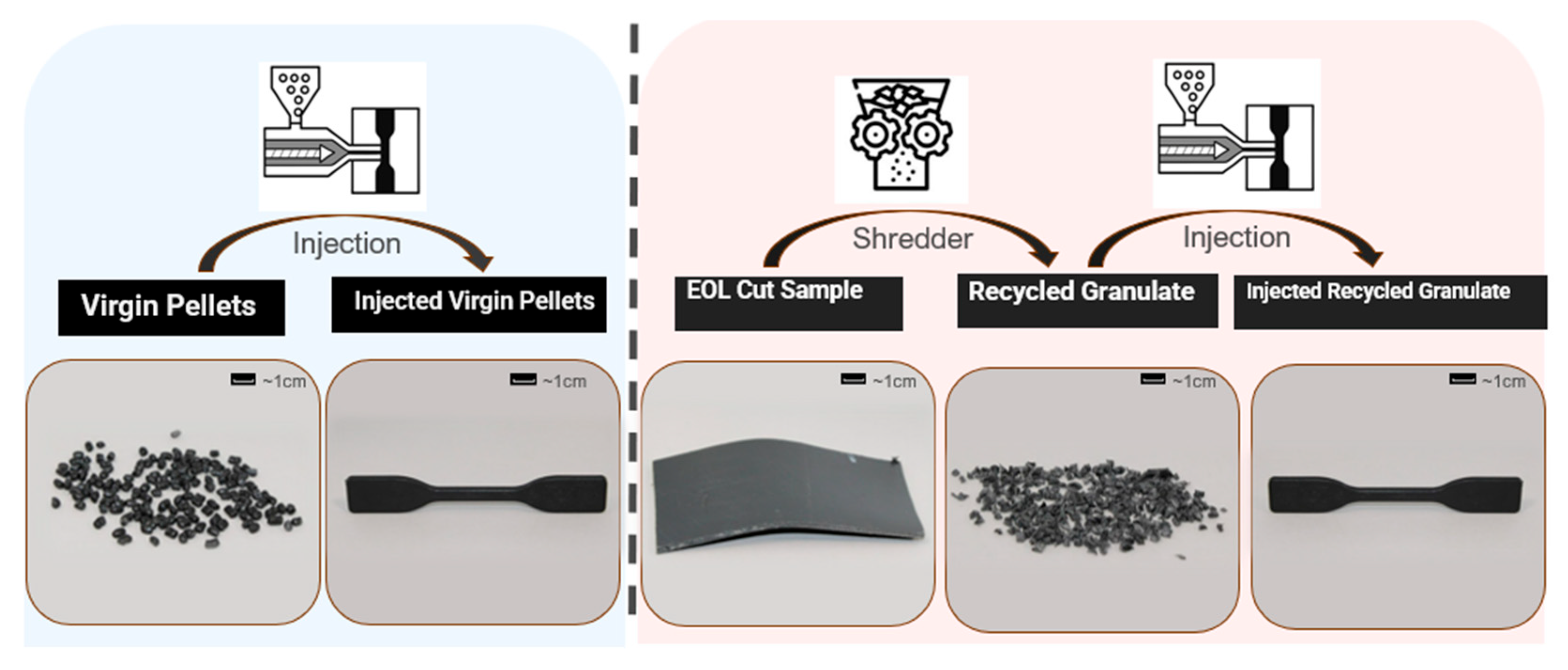
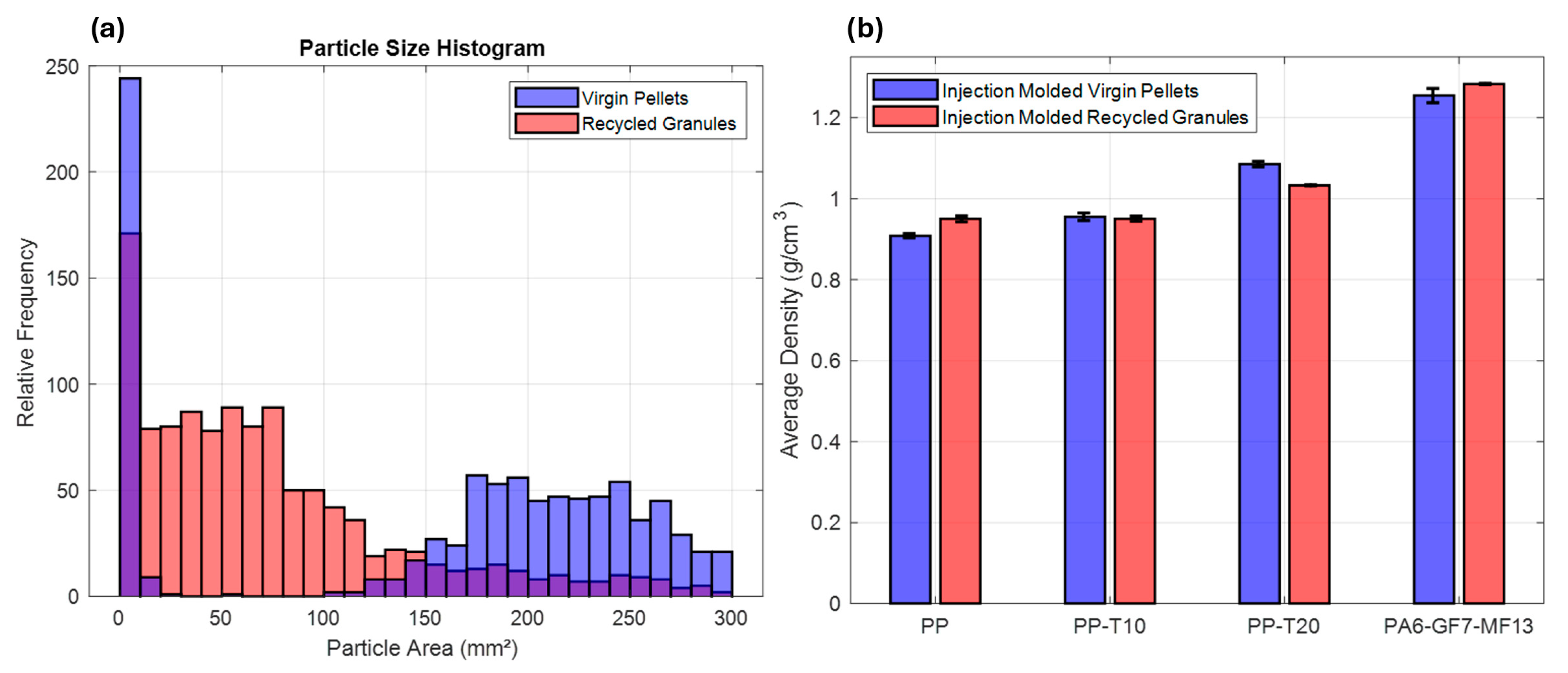
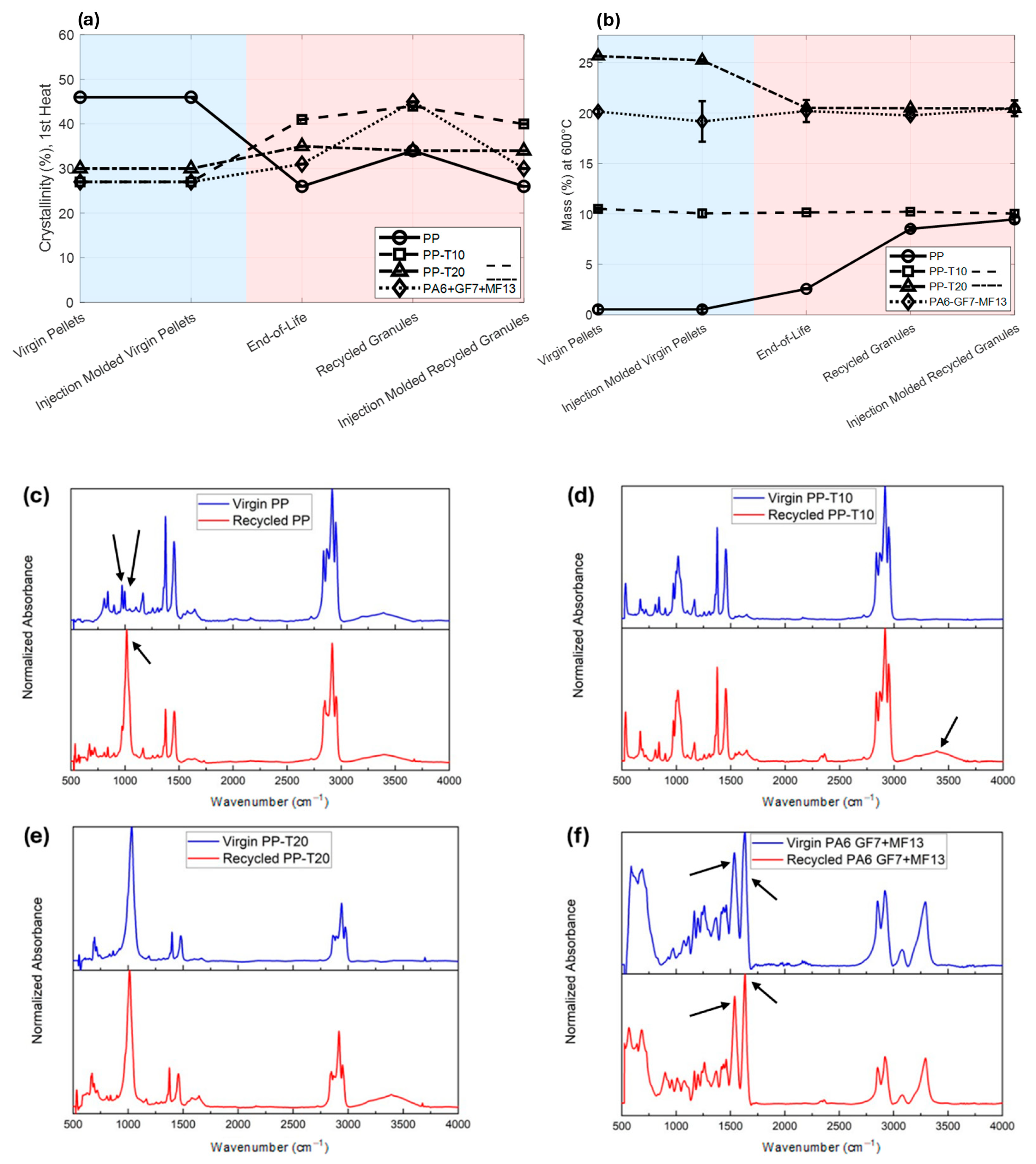
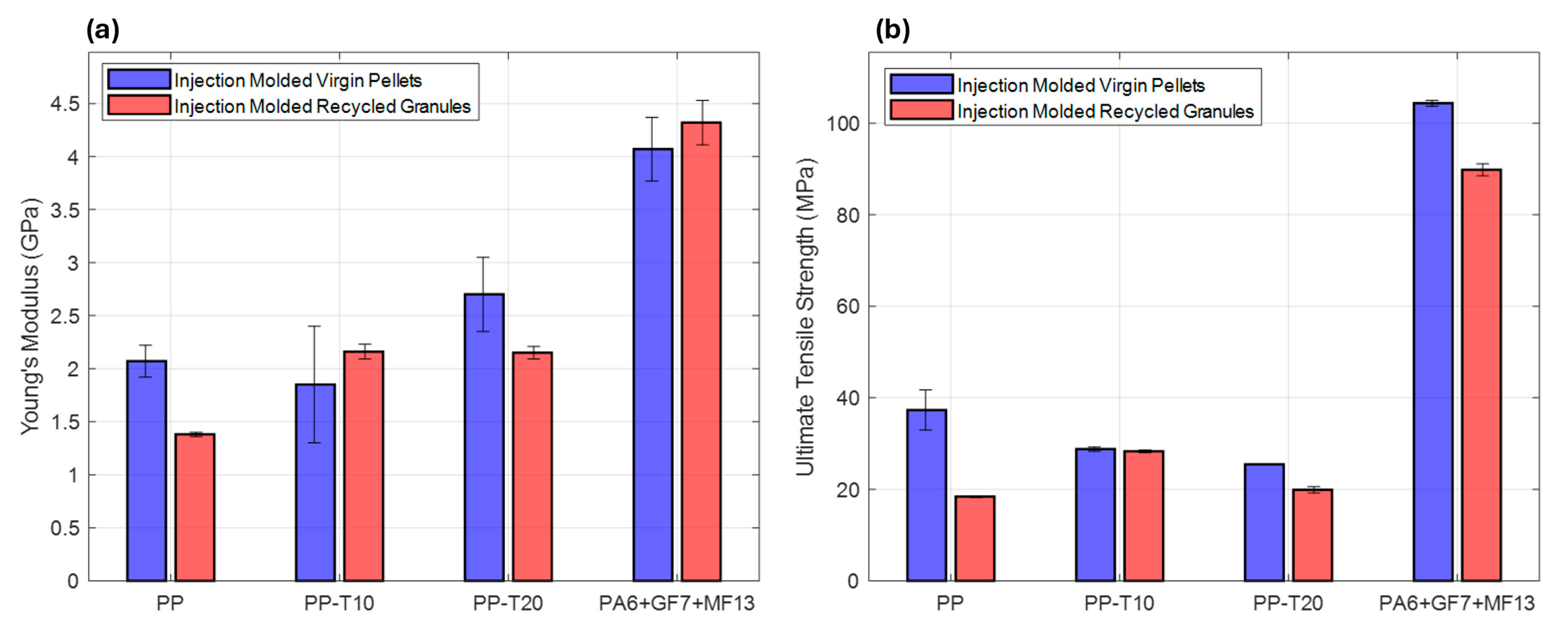
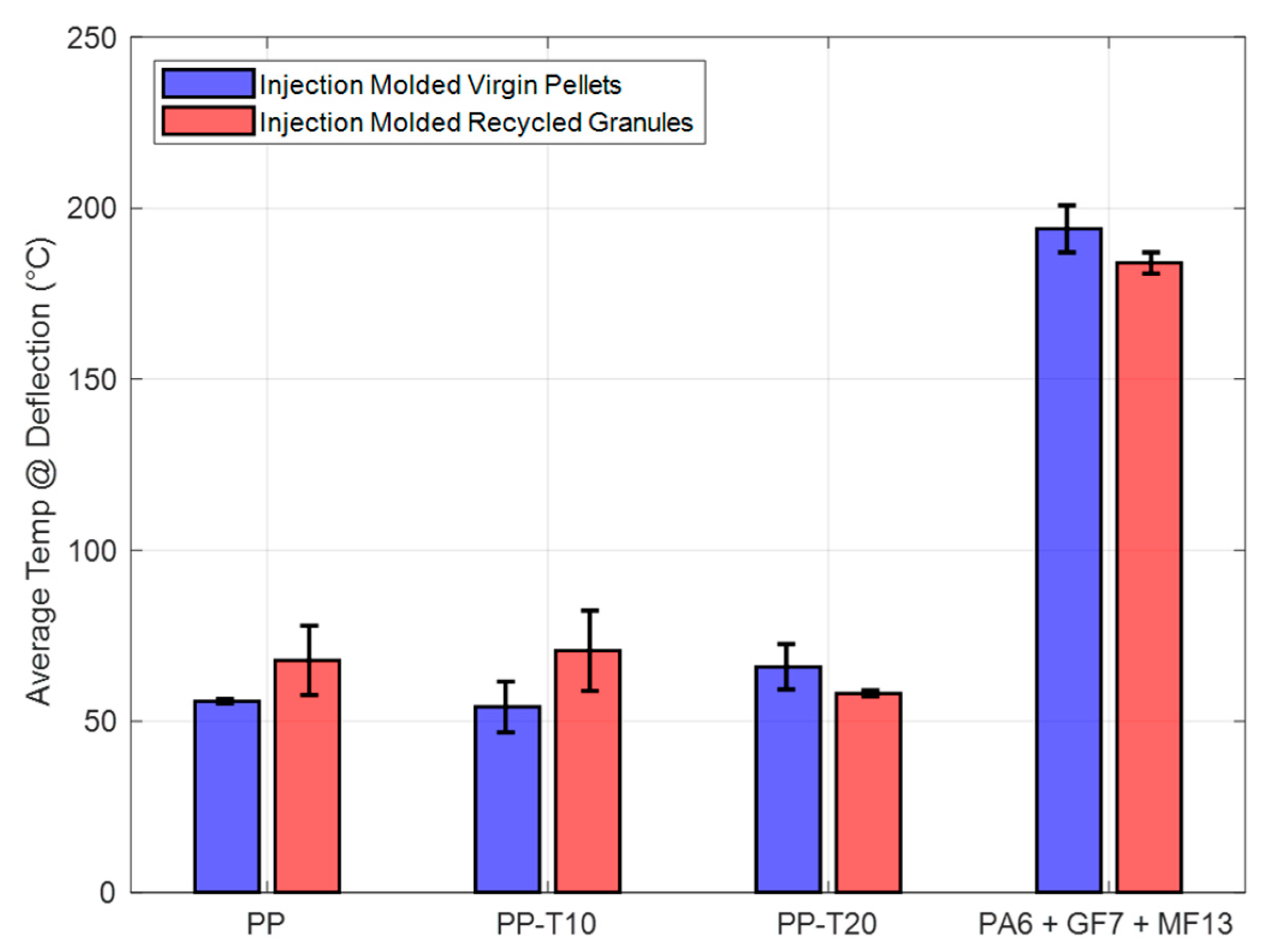
Disclaimer/Publisher’s Note: The statements, opinions and data contained in all publications are solely those of the individual author(s) and contributor(s) and not of MDPI and/or the editor(s). MDPI and/or the editor(s) disclaim responsibility for any injury to people or property resulting from any ideas, methods, instructions or products referred to in the content. |
© 2025 by the authors. Licensee MDPI, Basel, Switzerland. This article is an open access article distributed under the terms and conditions of the Creative Commons Attribution (CC BY) license (https://creativecommons.org/licenses/by/4.0/).
Share and Cite
Meshkat, N.; Korey, M.; Hubbard, A.M.; Slavny, K.; Anilal, A.L.S.; Das, A.; Kearney, L.; Ozcan, S.; Vaidya, U. Recycling Disassembled Automotive Plastic Components for New Vehicle Components: Enabling the Automotive Circular Economy. Recycling 2025, 10, 180. https://doi.org/10.3390/recycling10050180
Meshkat N, Korey M, Hubbard AM, Slavny K, Anilal ALS, Das A, Kearney L, Ozcan S, Vaidya U. Recycling Disassembled Automotive Plastic Components for New Vehicle Components: Enabling the Automotive Circular Economy. Recycling. 2025; 10(5):180. https://doi.org/10.3390/recycling10050180
Chicago/Turabian StyleMeshkat, Neeki, Matthew Korey, Amber M. Hubbard, Kathryn Slavny, Ashish L. S. Anilal, Arit Das, Logan Kearney, Soydan Ozcan, and Uday Vaidya. 2025. "Recycling Disassembled Automotive Plastic Components for New Vehicle Components: Enabling the Automotive Circular Economy" Recycling 10, no. 5: 180. https://doi.org/10.3390/recycling10050180
APA StyleMeshkat, N., Korey, M., Hubbard, A. M., Slavny, K., Anilal, A. L. S., Das, A., Kearney, L., Ozcan, S., & Vaidya, U. (2025). Recycling Disassembled Automotive Plastic Components for New Vehicle Components: Enabling the Automotive Circular Economy. Recycling, 10(5), 180. https://doi.org/10.3390/recycling10050180







